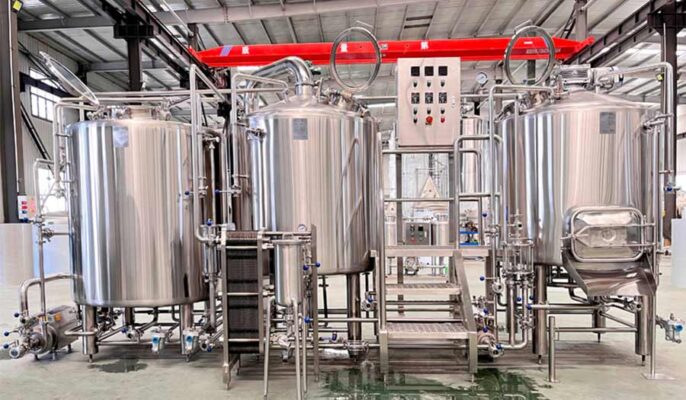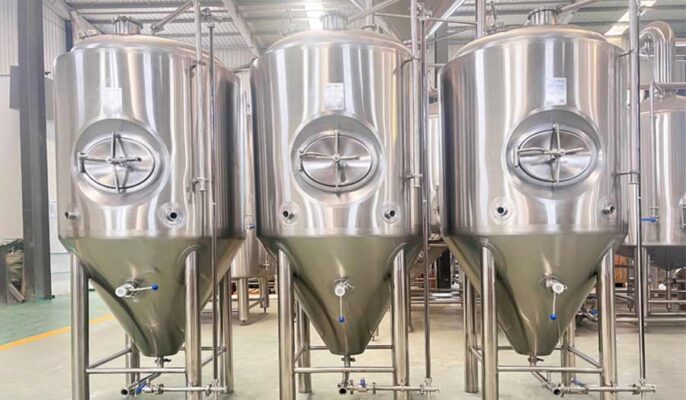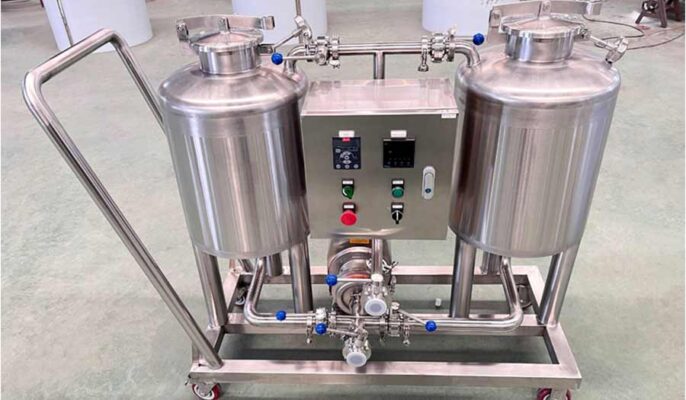600L microbrewery systems are suitable for breweries that are much smaller and owned than larger corporate breweries. This type of brewery is generally characterized by a focus on flavor and brewing technology. It can be placed in beer consumption places, restaurants, pubs, bars, hotels, tourism and shopping malls, etc.
Basic configuration of 600L brewing system
Malt grinding device
- Particle adjustable rolling crusher
- Flexible or steel augers to lift ground grain into the mash tun
600L brewhouse installation
- Various combinations of mashing barrels, filter barrels, boiling pots, and whirlpool barrels
- Hot and cold water tanks available in special combinations
- Infusion or decoction methods are designed
- Stainless steel is popular for being easy to maintain and clean, with optional copper cladding for
- Two-stage or single-stage heat exchanger for wort cooling
- Completely stainless steel integrated work platform
- Hygienic and efficient wort pump
600L fermentation device standard
- Stainless steel conical cylindrical fermentation tank
- Single size or double size, breweries often used in small breweries
- The number of tanks is calculated according to the fermentation cycle of various beers.
- All orifices, valves, pressure gauges, accessories, etc.
Beer filter (optional)
- Craft beer does not need filtration and can be bottled for quick drinking
- Plate and frame or candle DE (diatomaceous earth) filters for beer clarification
600L bright tank unit
- Standard stainless steel bright tanks for beer aging, conditioning, serving, carbonation
- Single or double size as fermenters are often used in restaurants or bars
- Can quantities are calculated based on various beers and functions
- All holes, valves, stones, instruments, accessories, etc.

Cooling device
- Insulated glycol water tank with or without copper coil
- High-efficiency chiller or refrigerator with frying pan for containing and mixing glycol liquids to provide cooling energy
- Sanitary centrifugal pump for circulating glycol water between tank and heat exchanger
- All pipes, fittings, insulation
Control unit
- Brewery with temperature and switch control
- Electrical control cabinet Electrical control cabinet with temperature and switch control for cooling components
- Including temperature controller, thermocouple, solenoid valve, etc.
- PLC with touch screen panel for special requirements
Other configurations
- Barrel filling and rinsing machines
- Portable or stationary CIP systems for cleaning tanks
- Steam boiler for brewery heating Brewing
600L brewing system parameters
| Capacity | 200L-500L/Batch |
| Material | SUS304 |
| Combination method | Mash/lauter tun, kettle/whirlpool tank |
| Application | Restaurants, bars, hotels, brewery |
| Heating way | Steam heating/Electric heating/Direct fire heating |
| Voltage | AC380/220V, 50/60HZ |
| Degree of automation | Semi-automatic/Fully automatic |
Microbrewery System Specifications
| Production capacity | Volume in US Gallon | Heating area | Tank diameter | Height |
| 200L/day | 53 US Gallon | 0.25m2 | 910mm | 2200mm |
| 300L/day | 79 US Gallon | 0.3m2 | 910mm | 2300mm |
| 500L/day | 132 US Gallon | 0.5m2 | 1160mm | 2400mm |
| 600L/day | 158 US Gallon | 0.6m2 | 1160mm | 2500mm |
| 700L/day | 185 US Gallon | 0.7m2 | 1260mm | 2500mm |
| 800L/day | 212 US Gallon | 0.8m2 | 1260mm | 2500mm |
| 1000L/day | 264 US Gallon | 1.0m2 | 1360mm | 2800mm |
| 1500L/day | 396 US Gallon | 1.5m2 | 1560mm | 2900mm |
| 2000L/day | 528 US Gallon | 2.0m2 | 1960mm | 3150mm |

Micro brewing equipment automation level
Manual system
- Ideal for nanobreweries and start-ups with a limited budget.
- Need to control temperature, time and ingredient addition .
- Provides a closer connection with the brewing process.
Semi-automated system
- Suitable for small breweries and breweries pursuing efficiency.
- Automate certain aspects such as temperature control and pump operation.
- Maintain a balance between control and labor.
- found in large craft breweries.
- Provides precise control over all aspects of brewing.
- Maximize efficiency, but cost more.
Budget considerations
- Determine your budget and check the costs associated with each type of system.
- Consider long-term costs, including maintenance and potential upgrades.
How are microbrewing systems different from traditional breweries?
It’s not difficult to notice the differences between microbreweries and traditional breweries. The most obvious difference is the amount of product they produce each year; microbreweries produce no more than 15,000 barrels, while traditional breweries produce millions of barrels. As volume increases, so does brand awareness.
Traditional brands of beer tend to have simpler flavors. Small breweries are experimenting more with ingredients and flavors, creating unique blends that are only suitable for certain seasons. They can also be stronger and more expensive than beers at traditional establishments.

How much does it cost to start a microbrewery?
This could be an interesting business opportunity for those who are passionate about brewing beer. As far as costs go, you should know that starting a small brewery from scratch is neither cheap nor easy. Generally speaking, your basic start-up operating costs range from $300,000 to $350,000. If you would like to learn more about the costs and all the equipment required to start your own microbrewery contact Micet. We will give you the most suitable solution and customized services.
The main resources you need to succeed as a commercial small brewery include:
- Practical business plan with clear goals
- Source for purchasing reliable equipment
- Partners with excellent business skills and keen insight
- You already have some proven pico or nano beer recipes.
- Great determination and resilience
Asked Questions
At what scale of brewery production is considered “micro-craft”?
The Brewers Association defines micro-craft breweries as those producing less than 15,000 barrels per year. This equates to brewing no more than 450,000 US gallons per year.
How much space does a microbrewery need?
Plan for a small 3-7 barrel microbrewery of at least 1,500-3,000 square feet. This includes the brewery plus fermentation rooms, cold storage, packaging areas, ingredients, laboratories and offices. The larger space allows for more comfortable production volumes and the ability for future growth.
What important utilities are needed to operate brewery equipment?
Main utilities include electricity, water, drainage, ventilation, refrigeration, gas pipes for any direct fired kettles and steam where applicable. Ensure adequate connection sizes, pressures, drainage slopes and staged distribution.




